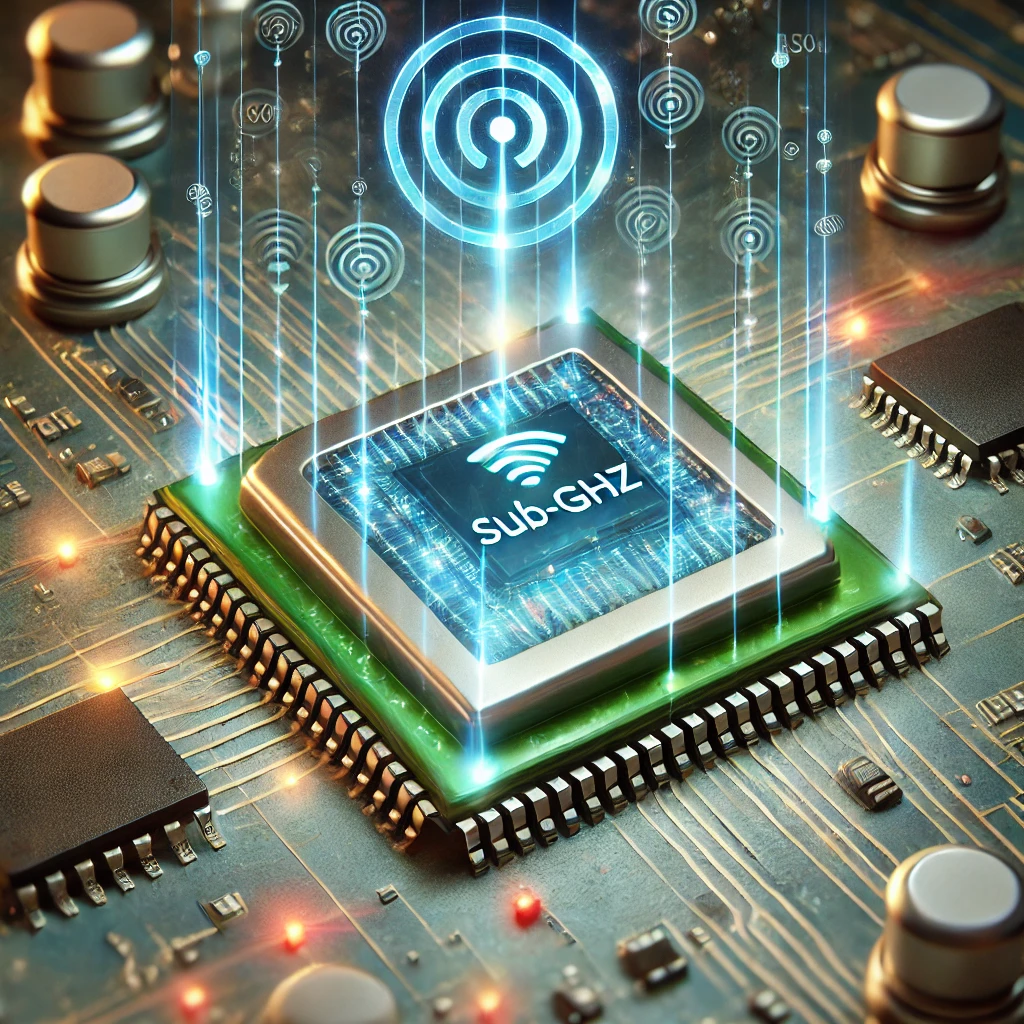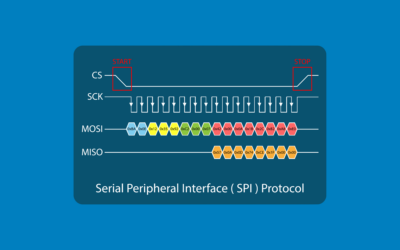Table of Content
Sub-GHz technology is critical in developing and deploying IoT solutions that require low power consumption and reliable long-range connectivity.
Mastering the basic concepts helps our clients choose the right components for their sub-GHz wireless systems, ensuring optimal performance for various IoT applications.
Krasamo, an IoT development company, provides expert guidance on selecting appropriate System-on-Chip (SoC) and module solutions for sub-GHz IoT applications.
As part of our IoT concept series, this paper illustrates the importance of sub-1 GHz technology, its application in real-world scenarios, and how it can optimize IoT networks for energy efficiency and range.
Sub 1 GHZ Essentials
Sub-GHz technology is increasingly important for IoT applications today for several key reasons:
1. Longer Range: Sub-GHz frequencies, such as 433 MHz and 915 MHz, offer superior transmission ranges compared to higher frequency bands like 2.4 GHz. This is crucial for IoT applications where devices may need to communicate over large distances, such as industrial automation or smart metering. It allows for reliable connectivity without requiring repeaters or additional infrastructure.
The range of sub-GHz systems can vary significantly depending on environmental factors, such as obstacles (e.g., buildings, metal objects) and interference levels, particularly in urban areas. To maximize range performance, careful consideration should be given to antenna placement and ensuring that elements like antennas are spaced out properly to minimize interference.
2. Better Penetration: Sub-GHz signals can penetrate obstacles like walls and buildings more effectively than higher frequencies. This characteristic is especially important in urban or industrial environments where physical barriers can obstruct communication. Maintaining a stable connection in such scenarios is vital for many IoT applications, including smart home devices and environmental monitoring systems.
3. Lower Power Consumption: Devices operating in the sub-GHz range tend to consume less power, which is critical for battery-powered IoT devices. Longer battery life is a significant advantage, as many IoT applications, such as remote sensors, require devices to operate for extended periods without frequent battery replacements. This low power requirement makes sub-GHz technology suitable for smart grids and agricultural monitoring applications.
4. Reduced Interference: The sub-GHz frequency bands typically experience less congestion and interference than the crowded 2.4 GHz band, which many devices use, including Wi-Fi and Bluetooth. This quieter spectrum allows for more reliable communication, fewer transmission retries, and improved overall efficiency in data transmission.
5. Cost-Effective Solutions: Sub-GHz wireless systems can be more cost-effective for low-data-rate applications. The lower cost of proprietary sub-GHz solutions and their simpler deployment requirements allow developers to implement IoT systems without extensive investment, making it easier for businesses to adopt IoT technologies.
Low-data-rate devices are electronic devices that transmit small amounts of data at slow speeds. They are commonly used in applications where high-speed data transmission is unnecessary. Still, factors like long-range communication, low power consumption, and extended battery life are more critical.
6. Wide Range of Applications: Sub-GHz technology supports diverse IoT applications, from smart home devices to industrial automation and smart grid technology. This versatility enables developers to choose the appropriate technology based on specific application requirements, enhancing the overall functionality and efficiency of IoT solutions.
7. Support for Standards-Based Protocols: Sub-GHz wireless systems often support a variety of standards-based protocols, such as Zigbee, Z-Wave, and LoRa, facilitating interoperability between devices from different manufacturers. This interoperability is essential for creating cohesive IoT ecosystems, allowing devices to work seamlessly.
Interoperability in sub-GHz wireless systems allows devices to connect in mesh networks, where each device can act as a node, extending the network’s range and robustness. This is particularly important for smart city applications and industrial IoT environments, where maintaining connectivity across various devices and systems is essential.
Sub GHz Concepts
We want to illustrate the importance of sub-GHz technology in modern wireless communication, particularly for applications requiring low power consumption and reliable long-range connectivity.
What is Gigahertz?
Gigahertz (GHz) is a unit of frequency equivalent to one billion hertz (cycles per second). It is commonly used to measure the frequency of electromagnetic waves, including radio frequencies. For instance, 2.4 GHz is a widely used frequency for wireless communications, such as Wi-Fi and Bluetooth.
What is Sub-GHz?
Sub-GHz, called sub-1-GHz, refers to frequencies below 1 GHz, encompassing bands like 433 MHz, 868 MHz, and 915 MHz. This frequency range is utilized in various wireless communication applications due to its advantageous properties, including a longer range and better penetration through obstacles than higher frequencies like 2.4 GHz.
What is Sub-GHz Used For?
Sub-GHz technologies are commonly used in applications such as:
- Industrial Automation: Sensors and devices communicate over long distances in highly interfered environments.
- Smart Metering: Utility meters (electricity, water, gas) transmit data reliably over long ranges.
- Smart Home Devices: Various IoT devices (such as security systems, environmental sensors, and smart locks) operate efficiently with low power consumption.
- Agricultural Monitoring: Wireless sensors help monitor soil conditions and optimize farming practices.
What is Sub 1 GHz Range?
The sub-GHz range typically refers to the frequency spectrum below 1 GHz, where sub-GHz wireless systems can achieve transmission ranges often exceeding a kilometer, especially in open environments. Factors like frequency (e.g., 433 MHz, 868 MHz, 915 MHz) and environmental conditions can significantly influence range performance.
What is a Sub-GHz Module?
A sub-GHz module is a pre-packaged component that includes all necessary hardware and firmware for sub-GHz wireless communication. These modules typically integrate a radio transceiver and may include microcontrollers, memory, and other components needed for specific applications, enabling developers to implement wireless functionality in their devices easily.
What are Sub-GHz Devices?
Sub-GHz devices refer to any electronic devices equipped to operate on sub-GHz frequencies. These include IoT sensors, actuators, remote controls, and smart meters, which take advantage of sub-GHz technology’s benefits, such as low power consumption and long-range communication capabilities.
What is a Sub-GHz Transceiver?
A sub-GHz transceiver is a device that can transmit and receive signals on sub-GHz frequencies. It typically includes a radio module that facilitates wireless communication by encoding and decoding signals. Transceivers are fundamental components in wireless networks, enabling devices to interact seamlessly.
What is a Sub-GHz Antenna?
A sub-GHz antenna is designed to operate effectively at frequencies below 1 GHz. Due to the inverse relationship between frequency and antenna size, these antennas are generally larger than those used for higher frequencies. For example, an optimal antenna for a 433 MHz application can be several inches long. These antennas ensure adequate signal transmission and reception in sub-GHz wireless applications.
Sub-GHz Networking Protocols
Interoperability with various standards Achieving interoperability is essential for successful sub-GHz deployments.
- Z-Wave
- LoRa
- Amazon Sidewalk
- Zigbee
- WI Sun
ISM Bands (Industrial, Scientific, and Medical)
ISM bands are specific radio frequency bands designated for use by industrial, scientific, and medical devices without the need for a specific license. They are intended for unlicensed operation to facilitate the development and deployment of wireless technologies and have similar usage rules and power limits that can vary.
ISM bands are recognized internationally, although the specific frequencies can vary by region. Common ISM bands include:
- 433 MHz
- 868 MHz (primarily in Europe)
- 915 MHz (primarily in North America)
- 2.4 GHz (widely used for Wi-Fi, Bluetooth, and Zigbee)
Devices operating in ISM bands typically must adhere to specific power limits to minimize interference with other devices and systems. Used for various applications, including remote controls, smart meters, medical devices, and wireless sensors.
The designated band, propagation characteristics, antenna sizes, and performance must be considered when designing IoT devices.
SRD Bands (Short Range Devices)
SRD bands are radio frequencies designated for short-range communication applications. Like ISM bands, they are typically unlicensed but have more specific operational requirements regarding transmission power, range, and duty cycle.
SRD applications are generally limited to short-range communication, making them suitable for personal area networks and specific IoT applications.
SRD bands often have stricter transmission power and duty cycle regulations to ensure they do not interfere with other communication systems, particularly in urban environments.
Commonly used for RFID, wireless medical telemetry, home automation, and other short-range communication technologies.
Designation of Sub GHz Bands
The designation of bands is determined by regulatory frameworks and power and range limitations that prevent interference with other services.
The primary reason for designating bands as short-range is to minimize interference with other licensed communication systems. Limiting the transmission range and power allows these systems to coexist without disrupting each other.
ISM bands have higher power levels than short-range bands and keep transmissions within specified limits to avoid disrupting other spectrum users. SRD bands have lower power limits and sometimes specified duty cycles (how long a device can transmit relative to its idle time) to ensure signals don’t propagate over long distances.
Many IoT and telemetry applications do not require long-range communication, so keeping the communication short-range allows the systems to operate effectively within their intended environments (like homes, hospitals, or factories) without extensive infrastructure.
Sub 1 GHZ Regulations
International and national regulations influence the designation of ISM and SRD bands. Organizations like the International Telecommunication Union (ITU) provide global frequency allocation guidelines. National regulatory bodies, like the Federal Communications Commission (FCC) in the U.S. and the European Telecommunications Standards Institute (ETSI) in Europe, implement these guidelines at a regional level.
Before designating specific bands, technical studies evaluate the potential for interference, operational efficiency, and the technical requirements of devices that use the band. These studies inform decisions on power levels, duty cycles, and frequency allocations.
Various standards organizations (e.g., IEEE, ETSI) develop technical standards for devices operating in these bands. These standards help ensure interoperability and compliance with the regulatory requirements.
Power Limits
Power limits are the maximum allowable transmission power for devices. Power limits define the maximum amount of radio frequency (RF) energy a device can emit. This is usually measured in milliwatts (mW) or decibels relative to a milliwatt (dBm).
Lower power limits (reduced range of signals) benefit applications that don’t require long-range communications and extensive infrastructure. Limiting the power output (transmit power) minimizes the potential for interference with other devices operating at the same frequency or in nearby frequency bands.
Devices operating under lower power limits tend to consume less energy, which is crucial for battery-powered applications.
Receiver sensitivity
Receiver sensitivity measures the lowest signal strength at which a receiver can accurately detect and decode a signal. Better sensitivity means the receiver can detect weaker signals, which improves range without increasing transmit power.
Optimizing transmit power and receiver sensitivity involves finding the right balance between signal strength and power consumption.
Propagation Characteristics
Devices can be classified in different sub-GHz frequencies and have different propagation characteristics. Higher frequencies generally have better data transmission capabilities but shorter ranges, while lower frequencies can penetrate obstacles more effectively but may have limitations in data rates.
Antenna Size
The wavelength of a signal is inversely proportional to its frequency. Thus, 315 MHz signals have a longer wavelength (approximately 0.96 meters) than 433 MHz signals (approximately 0.69 meters). Consequently, antennas designed for these frequencies will differ, with those for 315 MHz typically larger.
Business Benefits and Scalability
Sub-GHz technology offers significant advantages for businesses looking to optimize their IoT deployments. Not only does it improve connectivity with long-range communication and better penetration, but it also provides cost-saving opportunities by reducing the need for infrastructure like repeaters. This reduction in hardware lowers both initial and ongoing operational costs. Furthermore, with international standards and regulations, sub-GHz solutions can be easily scaled across different regions while maintaining compliance with local laws. This flexibility makes sub-GHz technology an ideal choice for global IoT deployments.
Contact our IoT consulting services team for more information about developing IoT systems and devices with sub-1 GHz connectivity.













